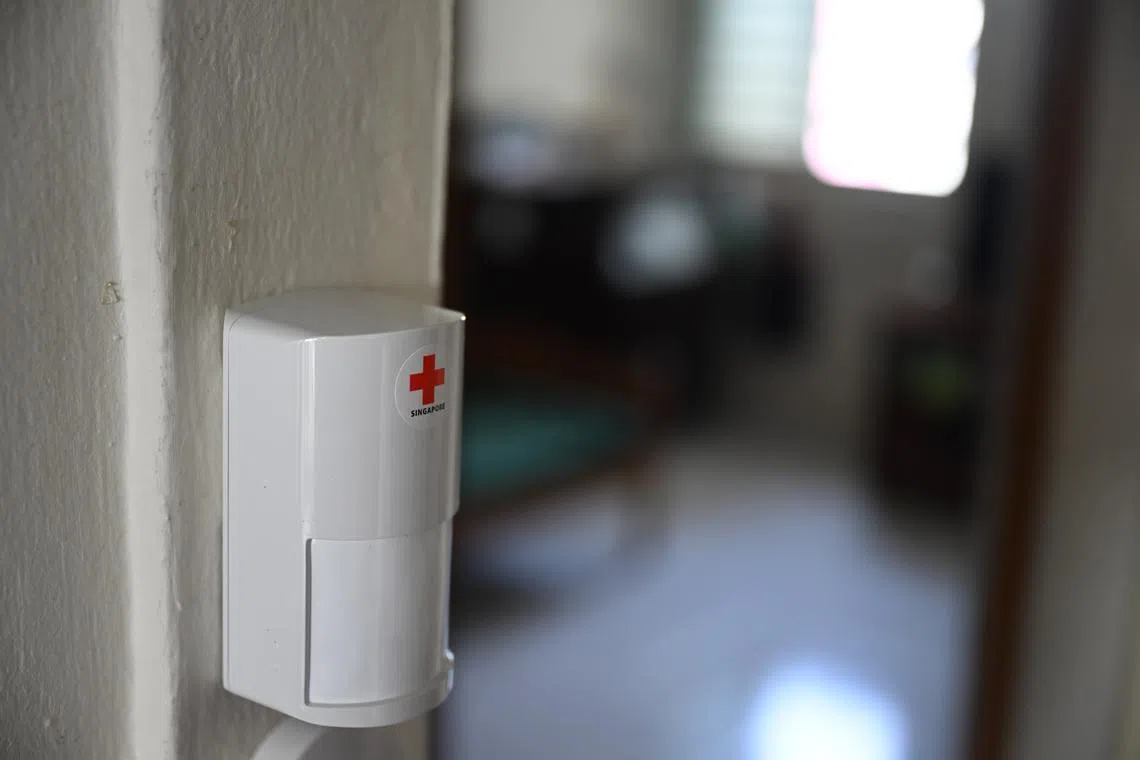Home alone, ill or in distress? Just press the button
Sign up now: Get ST's newsletters delivered to your inbox
Follow topic:
SINGAPORE – Losing her privacy was Madam Chan Woon Siong’s main concern when the Singapore Red Cross (SRC) installed four motion sensors in her Ang Mo Kio three-room flat four years ago.
She was also given two panic buttons. She wears one around her neck, and the other is installed beside her bed.
“Are these cameras recording my every move at home?” the 82-year-old retired cleaner asked the SRC team.
She was assured that the devices had no cameras.
Madam Chan, a widow with no children, is alone at home most of the time. She has hypertension and failing eyesight, and had previously experienced a few falls that weakened her legs.
She is a beneficiary of SRC’s Home Monitoring and Eldercare service, or HoME+, which provides seniors with a helpline for non-emergency situations and a monitoring, alert and response system for home safety.
When installed in a home, the system’s motion sensors trigger an alert in the event of prolonged inactivity. For instance, if a motion sensor is installed in the bathroom, the SRC call centre will be notified if there is a lack of activity for a period of time after the senior has entered the space.

One of the motion sensors in Madam Chan Woon Siong’s flat.
ST PHOTO: AZMI ATHNI
In an emergency, seniors can press their panic buttons to trigger an alarm at the SRC. Close to 90 volunteer community responders are rostered round the clock to be on standby to respond when activated.
When it was launched in 2017, the home safety solution was installed in the homes of 50 seniors living in Jurong Central. Over the years, it has expanded to serve about 450 clients islandwide.
SRC hopes to serve a total of 1,000 clients in 2024.
Mr Rajoo Shanmugam, 84, was part of the pioneer batch of beneficiaries in Jurong.
“I was fearful, especially at night,” said the retired clerk, who lives alone. “If anything happens to me while I’m sleeping, nobody will know.”
His fear was alleviated after the system was installed.

Mr Rajoo Shanmugam was in the pioneer batch of residents in Jurong who were beneficiaries of the Singapore Red Cross’ home safety service.
PHOTO: SINGAPORE RED CROSS
Singapore is set to attain super-aged status in 2026. By 2030, one in four citizens will be aged 65 and above,
Mr Benjamin William, SRC’s secretary-general and chief executive, said that as Singapore moves rapidly towards super-aged status, and with more seniors living on their own, it is important to provide practical help to these single seniors and support community ageing in place.
“HoME+ leverages technology and public-spiritedness to ensure home safety and independent living – akin to a warm security blanket for our seniors,” he added.
Mr William also hopes that more will step forward to train and volunteer as community responders so that SRC can serve more seniors.
Like Mr Rajoo and Madam Chan, two-thirds of the elderly beneficiaries live alone. The rest, who have family, are alone at home most of the time. Their average age is 78, with the oldest being 102 years old.
Sixty-two beneficiaries are fully funded by the SRC. The rest of the clients are full-paying or subsidised.
The HoME+ solution costs $48 in monthly subscription fees. As this is a social enterprise, the fees from full-paying clients go towards funding subsidies for those in need. They are mostly referred to SRC by hospitals and social workers.
In the past six months, there were 13 activations, including seven medical situations and three traumatic incidents that required an ambulance. Another three activations were accidental. The SRC said “medical situations” can range from unwitnessed falls to stomach aches.
Mr Don Anil, a 67-year-old retired car technician living in Serangoon, activated the emergency button in February 2020 when he experienced chest discomfort and felt weak. He was rushed to the hospital and spent four months in the special care unit.
“Whenever I feel that something is not right, I will reach out to press the button,” he said.
Community responder Sean Png, who started volunteering with HoME+ in 2020, has managed six incidents so far.
The 24-year-old once attended to a senior with fever, cough and shortness of breath in the middle of the night. He managed to persuade the senior to call an ambulance to seek immediate treatment at a hospital for Covid-19-related pneumonia.
Many seniors are grateful to be able to live independently while still staying connected to a safety net.
“I don’t want to be dependent on others,” Madam Chan said. “At least with this system, I won’t die alone at home and be discovered only a few days later.”

